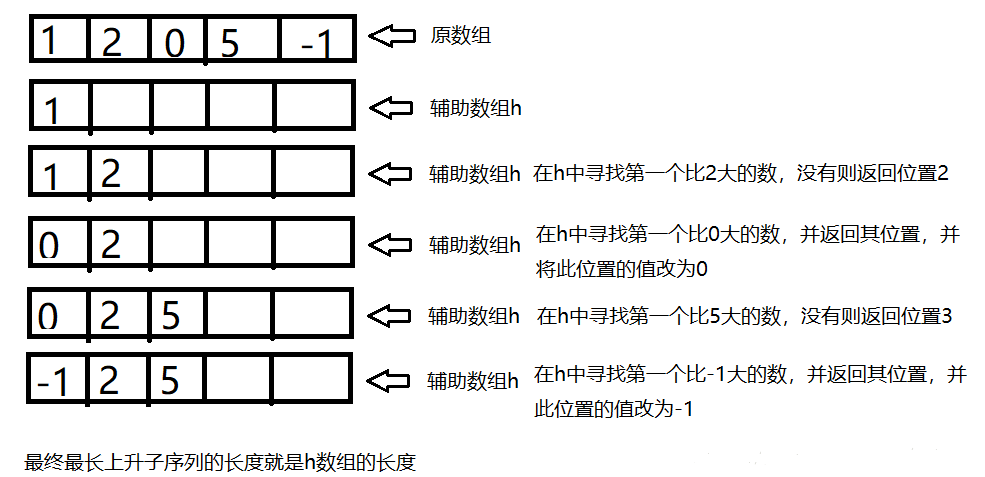首先得明白一个概念:子序列不一定是连续的,可以是断开的。
有两种写法:
一、动态规划写法
复杂度:O(n^2)
代码:
1 #include <iostream> 2 #include <queue> 3 #include <cstdio> 4 #include <algorithm> 5 #include <cmath> 6 #include <cstring> 7 #define INF 0x3f3f3f3f 8 9 using namespace std; 10 typedef long long ll; 11 const int maxn = 1000; 12 int a[maxn],dp[maxn]; 13 14 int main() 15 { 16 ios::sync_with_stdio(false); 17 int n; 18 while(cin>>n && n) 19 { 20 for(int i = 0; i<n; i++) 21 cin>>a[i]; 22 int mmax = -1; 23 for(int i = 0; i<n; i++) 24 { 25 dp[i] = 1; 26 for(int j = 0; j<i; j++)//遍历之前的每一个元素pre 27 { 28 if(a[j]<a[i] && (dp[j]+1>dp[i]))//如果元素pre < 当前元素cur,而且pre的长度+1要比当前的长度多就更新当前的长度 29 { 30 dp[i] = dp[j]+1; 31 } 32 } 33 mmax = max(mmax,dp[i]);//维护最大的长度 34 } 35 printf("%d ",mmax); 36 } 37 return 0; 38 }
二、low_bound写法
复杂度:O(nlogn)
这种写法就是将动规写法中的第二层的遍历改为了二分查找。所以复杂度变为O(nlogn)
该算法中开了一个辅助数组h来表示该长度下最后的元素的最小值。例如 1、2、0、5 、-1
为什么要修改h数组里边的数为小的值呢,因为修改后h数组能变长的潜力就增大了,所以要修改。
代码:
1 #include <iostream> 2 #include <queue> 3 #include <cstdio> 4 #include <algorithm> 5 #include <cmath> 6 #include <cstring> 7 #define INF 0x3f3f3f3f 8 9 using namespace std; 10 typedef long long ll; 11 const int maxn = 1000; 12 int a[maxn],dp[maxn]; 13 14 int main() 15 { 16 ios::sync_with_stdio(false); 17 int n; 18 while(cin>>n) 19 { 20 memset(a,0,sizeof(a)); 21 for(int i = 0; i<n; i++) 22 dp[i] = INF; 23 for(int i = 0; i<n; i++) 24 cin>>a[i]; 25 int mmax = -1; 26 for(int i = 0; i<n; i++) 27 { 28 int k = lower_bound(dp, dp+n, a[i])-dp; 29 dp[k] = a[i]; 30 mmax = max(mmax, k+1); 31 } 32 printf("%d ",mmax); 33 } 34 return 0; 35 }
